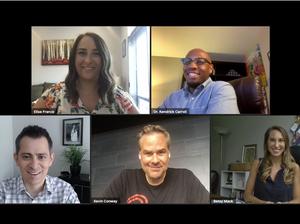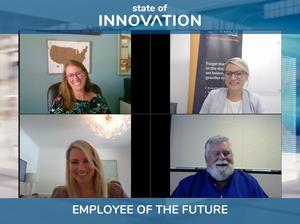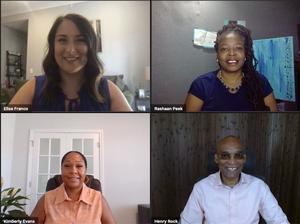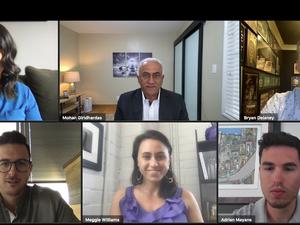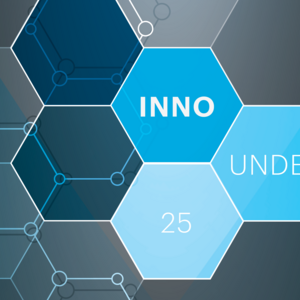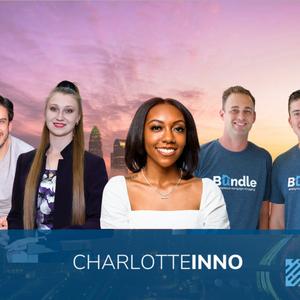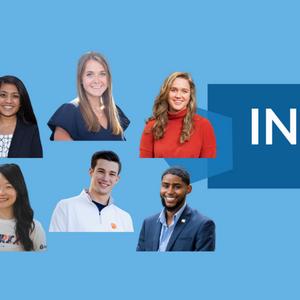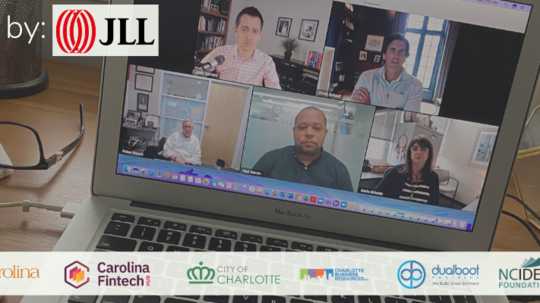
Charlotte Inno continued its virtual event series on Tuesday with State of Innovation: the future of work.
With a turnout of more than 100 founders, innovators and community members, the roundtable discussion focused on how different the workplace might look post-Covid 19. If you missed out on the live event, make sure to check out the recording below:
https://www.youtube.com/watch?v=SmI5u7vJnzY&feature=youtu.be
Charlotte Inno General Manager Juan Garzon moderated the hour-long conversation with Chris Schaaf, managing director of the Tenant Consulting Group at JLL; Peter Marsh, founder of Flywheel Coworking and owner of Workplace Architecture + Design; Rod Garvin, senior vice president of Talent Insights at Charlotte Regional Business Alliance; and Karla Shields, executive director of the Computer Technology Institute at CPCC.
Here are a few takeaways from the discussion:
What workplace trends are we likely to see as a result of Covid?
Chris Schaaf: The spatial environment was really leveraged before to create culture and build an environment that everyone wanted to go to. How do we go back to that by leveraging technology while we’re in this brief window (of Covid)? America’s "always on" work culture has reached new heights. Whatever boundaries remained between work and home life have simply disappeared. Peter Marsh: The pendulum has always kind of swung back and forth between the level of density and open plan vs. enclosed space. This is not a pendulum; this is a sledgehammer that has basically hit corporate office planning. We’re seeing a significant de-densifying of workplaces. It begins at the front door. I think what you’re going to see is a lot more elbow room and more of a residential feel coming into the work place. Karla Sheilds: We're starting to see companies are becoming a lot more flexible. I don’t really see anyone going back to 100 percent with no remote working. We’ve learned we can continue to work, can continue to have meetings ... We have a huge population that has really been effected where they didn’t have the choice of working from home or not. That is very critical, so whether it’s a shared working space or not … look at how do we get everybody back up and working. Rod Garvin: When we look at corporate offices, we’re going to see changes. What happens if how we think about headquarters is not as tied to a location. Some relocation decisions have been made by what is the best environment for a corporate office. Now we have to think about what business recruitment and expansion looks like when it’s not as tied to physical location. We will see changes in corporate real estate and how that factors into economic development, and that may actually elevate the significance of coworking.
How has the pandemic changed the way we work?
Peter: What a lot of people don’t understand about coworking is, (at FlyWheel) our typical space is around 20,000 square feet. That supports approximately 200 members. But on any given day typically only 30-50 people are in the space. So we’re actually able to accommodate social distancing in our current design without having to do a major reset. What's important to remember though, is that human beings are social animals. The ability to collaborate and feel that personal community connection virtually is ... never going to be replaced by the in-person experience. That exchange of ideas, even if you're wearing a mask, it's better than trying to do everything virtually. Rod: I've long been a proponent of employee freedom in terms of autonomy, flexibility, the opportunity to participate in the decision making of a company. People have tasted freedom, and there's no going back. The talent organizations want to attract and keep have experienced this. From an innovation standpoint, a lot of research showed there are benefits of remote work and benefits of that direct interaction, so a hybrid is ideal. Karla: For our students, for the clients we serve, what has always been the underlying tone is, "I live in Charlotte, I want to stay in Charlotte. Even if this great job is somewhere else, I want to stay in Charlotte." Now those doors, all those boundaries have been open, so you can stay here, be working for a company in New York or California ... because if you're bringing me the talent, the skills ... this has really broadened our ability to do different things.
Thoughts on tech implementation for safe social distancing:
Peter: We have already deployed tech that allows us to do interior positioning tracking. We deployed that so our community managers get an immediate notification if there's a violation of social distancing. There's a surge of all of these applications and just a thoughtfulness of how do we make our buildings more intelligent from a health standpoint (and) from a population management standpoint? These are going to have a lasting, positive impact on how we design buildings.
As we're using the offices less, will employees be given the support they need to work remotely?
Chris: Our clients have been highly supportive of their employees, whether it's giving them a stipend for X amount of dollars, or if they need to buy (something) for their office. So again ... when you talk about (working) out of these office buildings, it was exclusively (working) out of these office buildings. It going to change, and the change is going to be this hybrid approach. If it's going to change, and corporations are going to adopt it, which they have and they will, employers will also have to recognize the need that every single one of us are going to have to get some type of support on a monetary level so it's as efficient as a (work) office is.
Biggest future challenge and most exciting prospect?
Rod: We have to acknowledge a lot of folks are suffering right now. I don't think we're ever truly going to be post-pandemic. Business models will need to be in place to mitigate that (ongoing) risk. But what I'm excited about is the opportunity to truly create a new society where equity, where inclusion, where diversity is at the forefront of everything we do. We know there's not just a biological pandemic, but we're facing hundreds of years of a racial pandemic, as well. This is a once in a generation opportunity, but we have to get it right.
This event was powered by JLL.
Check out their tips for re-entering the workforce below:
Addressing how and when people should begin to return to space
Objective re-entry triggers
- Government mandates re-opening and occupancy
- Building, employee, and tenant spaces are safe and equipped for reuse
- Employee return-to-work plan confirmed
- Prepare protocols for re-closing
Stagger return to office
- Identify who will return to the o ice in the near-term—some employees may require extended remote work due to underlying personal factors, transit challenges and/or school closures
- If possible, create shifts based on social distancing in the workplace
- Number of shifts depends on company headcount and space capacity
- Maintain separation between teams returning to the o ice
New behaviors
- Communicate new protocols around cleanliness and gathering in common areas, as well as return- to-work timing and scenarios
- Impose travel restrictions on early returns
Office reconfigurations
- Redraw floor plans and reconfigure furniture (some of which may be required by new government mandates)
- Incorporate more touchless technologies for restrooms and trash receptacles
- Define cleaning and transition protocols for any shared workspaces
- Consider repurposing underutilized spaces
- Limit any desk sharing in the near term
Leverage technology
- Assess existing building technology that could help in providing and monitoring access and occupancy
- Consider new products in areas such as support for remote work, health screening, robotics, or touchless technology
Spatial distancing strategies
- Limit on-site meetings with clear guidelines
- Use videoconferencing and other virtual meeting technologies
- If holding in-person meetings, limit the number of attendees and maintain social distancing
- Plan for and manage congestion in common areas like elevator banks, cafeterias, and gyms
Limited common area and amenity access
- Limit occupancy using clear guidelines and shifts
- Manage higher demand and sanitation for microwaves and other equipment
- Encourage workers to bring food to the office or have lunch delivered in prepackaged containers to eliminate trips outside the office
- Limit congregation in any communal spaces, such as cafeterias, lounges and fitness centers
Additional considerations for investors, owners, and occupiers
Investor and owner considerations
- Recreational facility closures
- Gyms, showers, lockers remain closed or highly limited
Optimize air quality for health
- Retro fit HVAC handling systems for humidity control and supplemental filtration
- Review and apply any updated recommendations or standards from industry associations
- Assess and upgrade air filtration where needed to ensure use of proper and improved filters
- Ventilation systems—configure HVAC systems to run on full fresh air rather than recirculation— and pre-purge the air conditioning systems to improve indoor air quality for occupants
- UVG (Ultraviolet germicidal light) installation in air handling units
- Focus on wellness
- Assess and update WELL* building standards and certifications and promote a “healthy building” approach
Visitor protocol
- Consider health screening protocols (thermal or otherwise) and tracking within the space for all visitors
Owner-occupier and occupier considerations
- PPE and other health products
- On-site employees provided adequate masks, approved wipes, hand sanitizers, and any other infection prevention and health protection measures necessary
- Consider PPE and other health product availability, particularly at reception and other entry locations for use throughout the site
- Maintain adequate advanced inventory for any necessary PPE and other health products and maintain detailed audits
Mobile ordering from cafes
- Consider grab-and-go stations for pick-up and relationships with preferred vendors
- Employee health screening
- Implement health checks for employees that are consistent with corporate and/or authorized local jurisdiction guidance
Employee and tenant care and well- being
- Welcome back kits
- Experience and mobility ambassadors
Thank you to our founding partners and sponsors for making this event possible.
